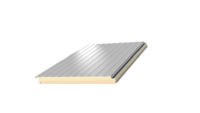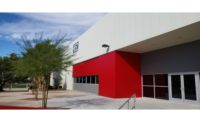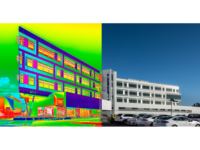There is a growing set of priorities observed by project design teams for energy efficient building design. “Envelope First Energy Efficiency” is a design philosophy, which considers the building’s exterior first, as the key to sustainability and the platform to build on for performance and aesthetics. Energy conservation measures are designed on the foundation of an optimized envelope design, with use of renewables to achieve Net Zero Energy.
High performance envelopes are critical to a building’s overall thermal efficiency, with energy code and “green” building standards raising the bar for exterior systems and assemblies. Insulated metal wall and roof panels are a factory built assembly well suited to achieve high standards for building envelope thermal performance. IMPs have gained wide acceptance in Europe and are beginning to see increasing design opportunities in North America.
Building envelope design decisions are driven by a multitude of factors. Aesthetics play a key role, but is always weighed with other factors such as material cost, construction cost, life cycle, cost of ownership etc. Thanks to energy performance standards like ASHRAE 90.1 and “green” rating systems like LEED, building energy efficiency and thermal performance are now an increased focus for most project systems and assemblies material decisions.
Code is the primary driver for insulation decisions in both new construction and retrofit projects. Regardless of environmental design initiatives, the code requirements, which determine the minimum R-values to be specified, are the principal influencers on the IMP configuration used in a given design. Whether insulation enhancements go beyond code minimums depend on other design related issues as well as what’s available in the budget.
The achievement of net-zero energy (a building that produces as much energy as it consumes and produces zero annual carbon emissions) has become the next opportunity for many new construction projects. As the retrofit market grows exponentially as part of the aging American infrastructure landscape, energy performance has become critical. Insulated metal panels present practical opportunities in both markets for wall and for roof applications.
The growing use of IMPs allows project design teams to create integrated building exteriors with stunning appearances, which also perform to the highest standards. These versatile exterior solutions are relatively easy to install and deliver many practical advantages for commercial walls and roofs.
WHAT ARE INSULATED METAL PANELS?
The CSI Master Format describes roofing and siding IMPs as “a wall or roof assembly composed of an insulated polyisocyanurate core material sandwiched between two cold rolled pre-coated steel skins, utilizing an interlocking joint for a weather tight vapor barrier and insulating system.” The definition broadens slightly as IMP manufacturers offer options such as rock wool, puf, or polyurethane cores, with enhanced fire retardant properties and other unique applications.
The majority of insulated metal panels are made with polyisocyanurate (polyiso) cores due to the superior insulating properties of polyiso and its ease to manufacture. Polyiso is one of the most energy efficient insulating materials used in commercial building due to its dense closed cell cell composition. With the highest R-value per inch of any common insulation material, it’s ideal to create a rigid board product.
Some of the most familiar applications for IMPs include cold storage buildings, office and convention centers in extreme climates, sports complexes, food processing plants, new manufacturing facilities and utility buildings.
IMP MANUFACTURING
IMP’s are manufactured using either of two processes: “lamination” or “foamed in place.” The foamed in place process injects foam between the two sheets of metal and bonds to the metal skins via a chemical reaction as it fills up the interior portion of the panel. The foamed in place process is preferred for higher volume projects requiring many consistent width panels and less factory customization. In this process the core is curing while it’s between the panels, which may create tiny air spaces. Even though these are minute they can have some influence on solar heat gain in certain applications contexts.
The lamination process bonds a “pre-cured” and shaped polyiso panel board between two steel or aluminum panels. This allows some of the de-gassing to take place prior to bonding and permits pre-lamination inspection of the boards prior to the bonding process, so the quality and consistency of the foam core is much more likely, especially in more customized designs.
Regardless of the process used in manufacturing, it’s the manufacture itself that becomes one of the leading benefits of IMPs. Since they’re assembled in the factory, the quality and consistency of each product is assured. The customization takes place prior to arriving at the job site and is figured into the cost. Factory built IMPs are durable and long lasting because finishes are applied in the factory under optimum conditions. Environmentally friendly weather resistant coatings, textures and finishes are designed for maximum long term performance.
SIMPLIFIED INSTALLATION
Construction cost is a key factor in both new construction and retrofit. Cost savings during the construction process make IMPs attractive. Because the IMP is a single component, installation on site is simplified. Installation takes place more quickly, due to fewer process steps. Because IMPs combine the elements of a multi-component system into one installation, the IMP installation process requires fewer passes around the building.
The erector works with a lightweight component, so handling and manipulation is uncomplicated. Because of the light weight of these modular components there are also framing and foundation requirements which are simplified. For example, support girt spacing of 8 to 12 feet can be used on many projects because of the relatively high panel strength and structural integrity of the systems. This creates other project economies and benefits.
A mounting system using concealed fasteners eliminates the need for multiple fastener types such as those required when multi-components are used, and also contributes to structural integrity and stability. Additionally, installation isn’t limited by temperature and weather conditions which can sometimes impact individual components in multi-component interior-exterior wall systems.
According to the Metal Construction Association, insulated metal panels can be erected by a four-man crew at a rate ranging from 1,100 square feet per hour on a architectural project, to 5,000 square feet per hour on an industrial project.
From a standpoint of building speed and economy, IMPs also provide benefits for the interior of the building. In some industrial installations such as warehouses, the interior metal skin of the IMP becomes the finished wall system.
Framing can be added to the interior skin and finished with drywall or another kind of interior finish can be added. Additional layers of insulation or radiant barrier material may be added in applications such as cold storage of in extreme climates.
These factors and others find IMPs reducing construction costs significantly for the exterior portion of the building. In a construction climate where every effort is made to reconcile overall cost, maximize job efficiency and building performance, the productive build speed of insulated metal panels positions them competitively in North America.
ENHANCED BUILDING PERFORMANCE
One of the principle reasons to favor a thermal continuity solution such as insulated metal panel is thermal performance. There are considerable long term benefits which make using IMPs an important building performance product choice.
Insulated metal panels combine a fully functional thermal continuity system with an exterior finish. Thermal brakes are created naturally since the metal on the interior side is completely separated from the exterior surface by the foam core. This is ideal to prevent thermal bridging and assist in containment for heating and cooling.
The high performance finishes applied in production to IMPs require significantly less maintenance than many exterior finishes or claddings applied in the field over thermal continuity. Most manufacturers offer technical finish options with reflective properties, which also increase performance.
Additionally, moisture and air infiltration are reduced or eliminated due to the tightly fitting joints. IMPs add a weather resistant, moisture resistant barrier system without having to add additional components.
In most applications IMPs are weighted heavily for their insulation values. Those panels with polyiso cores generally have no lower R-value than 6.5, and can range as high as 42, depending on material thickness and composition. The R-value of 6 inch thick panel can exceed 40, exceeding most LEED requirements and ASHRAE 90.1 future standards.
THE FUTURE
IMPs are a technology solution for sustainability consideration with practical advantages. As project designers look to specify efficient, cost effective materials which perform to the continually evolving building standards, IMPs will continue to evolve in design and performance with new attractive features.
In a building design, which requires long term performance, a premium product investment offset by efficient installation cost and perpetual improved performance levels will make IMPS worthy of strong consideration.







Report Abusive Comment